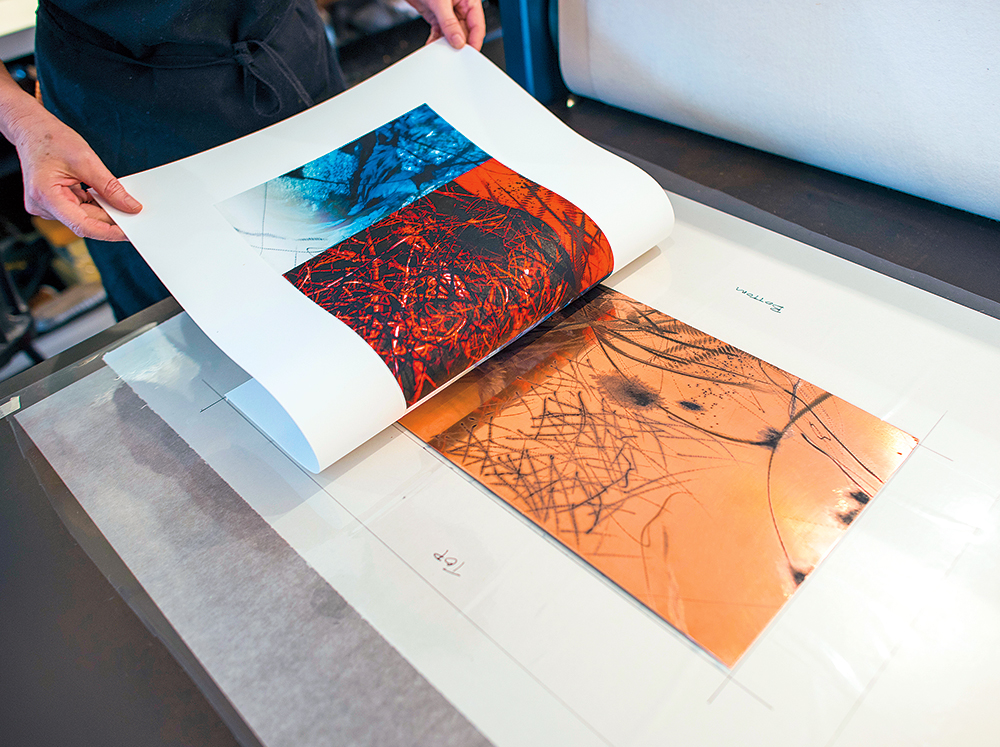
[Photo Credit: John Ulan]
In the 1970s, when Liz Ingram joined her colleagues Walter Jule and Lyndal Osborne to develop the University of Alberta's printmaking program, its success was far from a sure thing. At its inception, there wasn't a single other graduate program in Canada dedicated to creating original artworks by printing on paper using techniques such as lithography, etching and woodcuts. And Edmonton didn't seem to have a lot in common with the art form's traditional centres in Japan and Europe. Could the next Rembrandt, Degas or Warhol - all notable printmakers - really come from the Prairies?
Forty years later, Ingram and her colleagues appear to have proven skeptics wrong. Under their guidance, the now internationally renowned program has become a magnet for aspiring printmakers. It has also produced world-class artists and professors, many of whom use their UAlberta credentials to land hotly contested jobs around the globe.
What makes printmaking so special?
Each piece is individually made, usually hand-printed, and is signed by the artist. Fine art prints are considered original works, unlike reproductions, which are mass- produced photographic copies of artworks originally created in another medium. Printmaking has a history of adapting commercial techniques in unique ways for specialized uses by artists. Today, print artists often combine methods from the 1400s, like woodblock and engraving, with the latest in digital technologies and explore new image-making possibilities at the cusp of contemporary artistic practice.
What makes UAlberta's printmaking program unique?
In a lot of schools, students just go into the general master of fine arts program, and they move around a lot within the program. But because we've developed this incredible reputation, we get a lot of applications from all over the world from people who want to come here specifically for printmaking. That doesn't mean they can't work in other areas, but the fundamental basis of their thesis work and development is in printmaking.
Graduates of your program have landed prestigious jobs around the world. In what kinds of places have they ended up?
We're so proud of our grads. Monika Niwelinska, for example, is teaching at the Kraków Academy of Fine Arts, which has the strongest reputation in Poland. Rebecca Beardmore is at the Sydney College of the Arts in Australia. Koichi Yamamoto is a professor at the University of Tennessee, which has one of the top American programs for printmaking. [Our graduates] do really well in the American job market. It's unbelievable, because [at U.S. institutions] they can get 300 or 400 people applying for academic jobs in printmaking.
Many other graduates are involved in the community cultural sector and are working as successful artists outside of academics. One of the most celebrated visual artists in the world, Janet Cardiff, is an alumna of our printmaking program.
What would be possible for UAlberta's printmaking program with additional philanthropic support?
Many students make print installations, which get quite sculptural, large-scale and interactive. But we don't have the physical space [for more]. Most importantly, we need faculty members. We've lost positions and are very nervous about how small the whole area is becoming. We've always had three [faculty] in printmaking. Now we're down to two and I'm going to be retiring. We have outstanding graduate applicants, and we have the success rate. But that's what we really need: more flexible space and, above all, more faculty.
In a world that's becoming increasingly digital, why do you think students are still drawn to a tactile art like printmaking?
It's really interesting. We went through a phase where students just wanted to be on the computer, working out their imagery on the screen. By contrast, lithography is very physically demanding. You create your drawing surface by graining a stone, which is like working in a quarry. So for some time the students were somewhat reluctant to get engaged [in lithography]. But now, they want it and love it! They're so excited about being involved with something so physical and tactile. I believe that we think with our hands and our brains. It would be terrible to lose that.